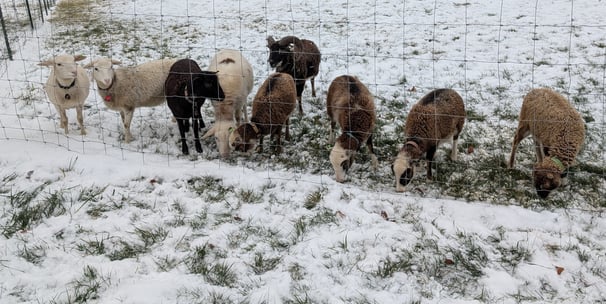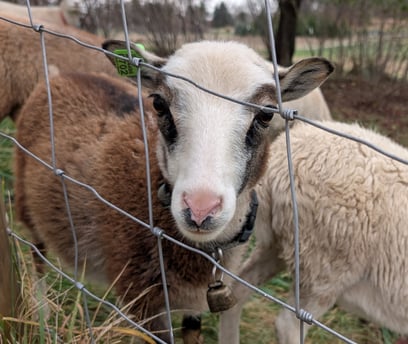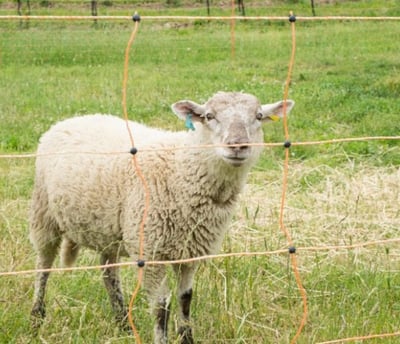Pasture Health
Establishing and maintaining a high-quality pasture is one of the best investments you can make for your sheep flock. A well-managed pasture provides excellent nutrition, promotes exercise, and can help reduce internal parasite loads when managed correctly. For a climate like Michigan's, focusing on productive, persistent cool-season forages is key.
Here’s an overview of what to consider when planting a pasture for sheep:


Why Pasture Diversity Matters
Planting a mix of different grasses, legumes, and forbs (broadleaf plants) is generally much better than planting a single species (monoculture). A diverse pasture offers several benefits:
Improved Nutrition: Different plants offer different nutrient profiles (protein, energy, minerals) and mature at different times, providing a more balanced diet over a longer grazing season (Pasture for Life, n.d.).
Resilience: A mix is more likely to withstand environmental challenges like drought, heat, or wet periods, as some species will thrive when others struggle.
Soil Health: Different root structures (deep taproots vs. fibrous roots) improve soil structure, water infiltration, and nutrient cycling (Farm Stand App, 2025).
Palatability & Intake: Sheep often prefer variety and may have higher intake on diverse pastures (RaisingSheep.net, n.d.).
Potential Health Benefits: Some forbs and legumes contain compounds (like tannins) that may help reduce internal parasite burdens (Pasture for Life, n.d.).
Key Components of a Sheep Pasture Mix
A good mix typically includes a base of grasses along with one or more legumes, and potentially some beneficial forbs.
1. Cool-Season Grasses (The Foundation)
These form the bulk of the forage and provide energy. Good options for Michigan include:
Orchardgrass: Very productive, palatable (especially newer varieties), and regrows well after grazing. It forms bunches and tolerates some shade. It's a highly desirable pasture grass for sheep (Cornell Small Farms, 2016).
Perennial Ryegrass: Establishes quickly and offers very high-quality, digestible forage. It thrives under intensive rotational grazing but can be less winter-hardy or drought-tolerant than other options.
Tall Fescue (Endophyte-Free or Novel Endophyte ONLY): Extremely hardy, persistent, tolerates heavy grazing and drought, and is excellent for stockpiling (extending grazing into late fall/winter). Crucially, you MUST plant endophyte-free or novel/friendly endophyte varieties. Traditional Kentucky-31 Tall Fescue contains a toxic endophyte that can cause serious health problems in sheep (poor growth, heat stress, fescue foot).
Kentucky Bluegrass: Very persistent, forms a dense sod, and tolerates close grazing well. It's lower yielding than some other grasses and can go dormant during hot, dry summer periods.
Timothy: Very palatable, especially for hay, but less tolerant of frequent, heavy grazing compared to orchardgrass or ryegrass. It performs best in cooler, moister conditions (MSU Extension, 2020).
Smooth Bromegrass / Meadow Bromegrass: Palatable and persistent, but can sometimes become less productive over time ("sod-bound"). Meadow brome has better regrowth potential.
2. Legumes (The Protein & Nitrogen Powerhouses)
Legumes fix nitrogen from the air, reducing fertilizer needs and boosting the protein content of the pasture.
White Clover (Ladino, Dutch, etc.): A pasture staple. It's highly palatable, nutritious, tolerates grazing well due to its low growing points, and spreads via stolons. Ladino types are larger and higher yielding than common White Dutch (UMass Amherst, n.d.).
Red Clover: Higher yielding than white clover but generally shorter-lived (2-3 years). It has excellent seedling vigor, making it good for improving existing pastures (frost seeding). It prefers well-drained soils but tolerates lower pH than alfalfa (Ohio State University, 2018).
Birdsfoot Trefoil: A non-bloating legume that is excellent for pasture. It contains tannins, which can help prevent bloat and may reduce parasite loads. It tolerates less fertile soils and can reseed itself, making it very persistent once established, though it can be slow to start (University of Minnesota Extension, n.d.).
Alfalfa: The "Queen of Forages" due to its high yield and quality. However, it requires deep, well-drained soils, a high pH (>6.5), and careful grazing management to prevent bloat, which can be a serious risk for sheep grazing lush alfalfa stands. It's often better used as a component in a mix rather than a pure stand for grazing sheep.
3. Beneficial Forbs (The Vitamin & Mineral Boosters)
Adding certain broadleaf plants can enhance nutrition and pasture health.
Chicory: A deep-rooted perennial forb that is highly palatable and digestible. Its taproot makes it drought-tolerant and helps bring up minerals from deep in the soil. It offers good summer growth when cool-season grasses slow down and has shown potential anthelmintic (anti-parasite) properties (Pasture for Life, n.d.).
Plantain (Broadleaf/Perennial): Not the weedy type, but improved forage varieties. It's rich in minerals, palatable, and tolerates grazing well (RaisingSheep.net, n.d.).


By investing in a diverse, well-managed pasture, you provide your sheep with high-quality, low-cost nutrition for much of the year, contributing significantly to their overall health and productivity.


Creating Your Mix & Getting Started
Soil Test: Always start with a soil test. This tells you your soil's pH and nutrient levels (P, K, etc.). MSU Extension can help with testing and interpretation. You need to correct pH (usually with lime) and fertility before planting for best results.
Choose a Mix: Work with a local seed supplier or your MSU Extension agent to select a pre-made "sheep pasture mix" or create a custom blend suited to your specific soil type and goals. A common approach is:
50-70% Grasses (often 2-3 different types for varied growth)
30-50% Legumes (usually 1-2 types, like white clover and birdsfoot trefoil)
A small percentage (5-10%) of forbs like chicory or plantain.
Establishment: Follow proper planting procedures – good seedbed preparation (or no-till seeding into existing pasture), correct planting depth (usually very shallow), and timing (often late summer or early spring in Michigan).
Manage for Success: Your intensive rotational grazing system is ideal for maintaining a diverse, high-quality pasture. It prevents selective grazing (which allows less-palatable plants to take over) and gives all species, especially legumes and forbs, time to recover and thrive.
